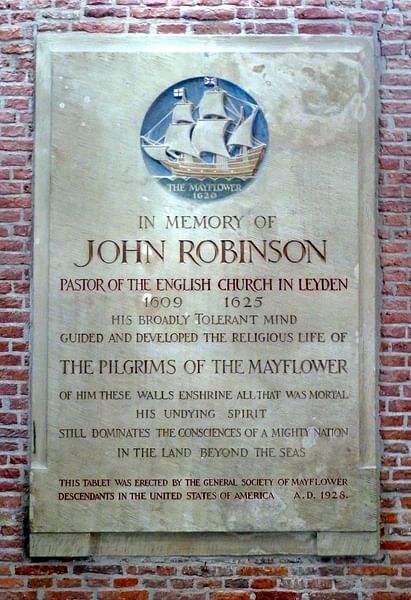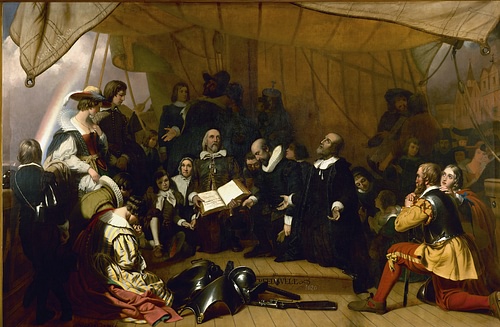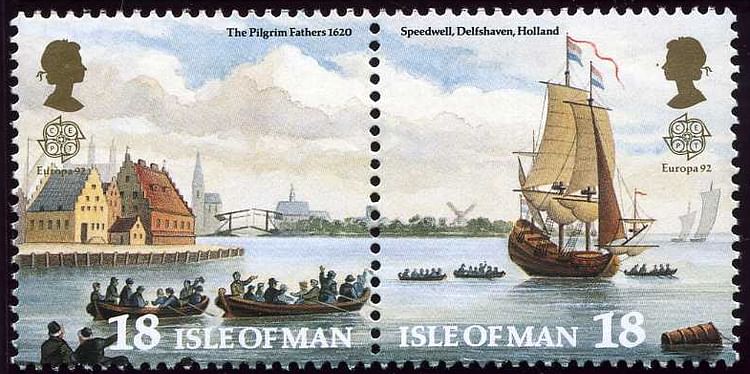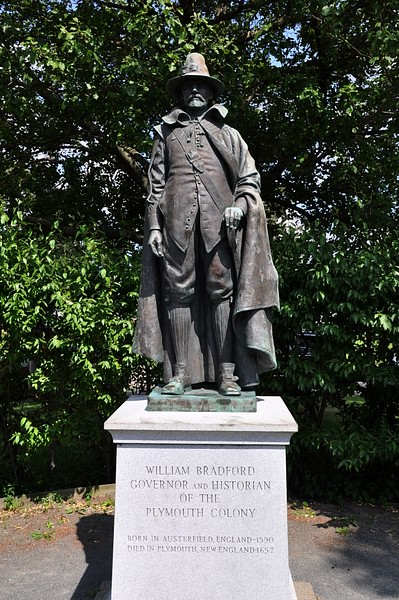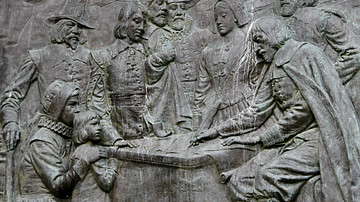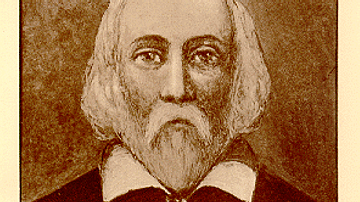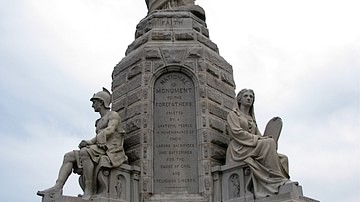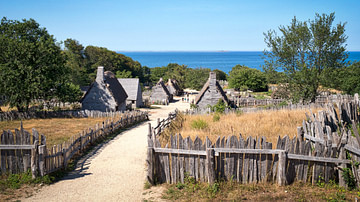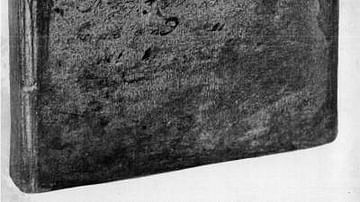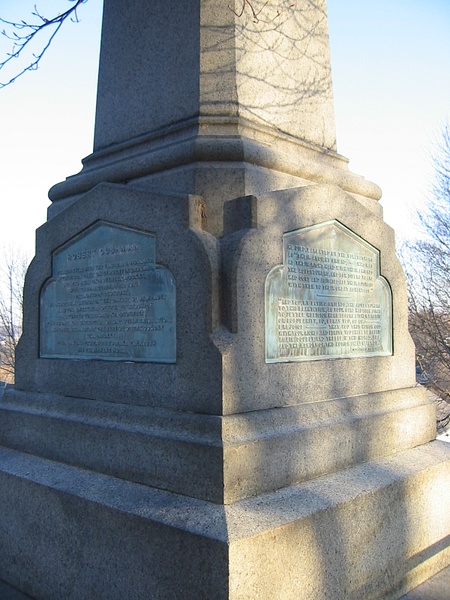
Robert Cushman (l. 1577-1625 CE) was an author, lay preacher, and member of the Leiden congregation of separatists (later known as the pilgrims) who negotiated passage for them from the Netherlands to North America in 1620 CE aboard the Mayflower; a voyage which would result in the foundation of the Plymouth Colony in Massachusetts and the establishment of the first successful English settlement in New England. He is also author of the book The Cry of a Stone, published posthumously in 1645 CE, the first published sermon delivered in North America in 1621 CE, and the man who brought back the first narrative of the Plymouth Colony, published as Mourt's Relation, in 1622 CE. He is best known, however, for securing passage and working out the details of financing the Mayflower voyage.
The separatists of Leiden who made that voyage were English who had left their homes fleeing persecution by King James I of England (r. 1603-1625 CE) and, once in the Netherlands, found they needed to relocate again. Mostly farmers, who had little experience outside of their village, the members of the congregation had no skill in negotiating anything like a transatlantic passage while Cushman, who had been a candlemaker, grocer, and wool merchant, had connections in urban business circles and, though he had never brokered such a deal either, was considered the best man for the job.
Cushman and another of the congregation, John Carver (l. 1584-1621 CE), worked with the merchant adventurer Thomas Weston (l. 1584 - c. 1647 CE), a man who matched investors with potential colonists, to equip and fund the expedition, but these negotiations did not always go smoothly. Carver, though also a man of means with experience in negotiation, was not interested in compromise when it came to the ideals of the congregation, while Weston was a businessman who could not possibly have cared less for the congregation's religious beliefs and was only interested in profit. Cushman was caught not only between these two but between the interests of his congregation and those of the investors but maintained balance in order to close the deal. He is considered among the most important, though often overlooked, figures of the Mayflower story for his work in making the pilgrim's voyage possible.
Early Life & Religious Persecution
Little is known of Cushman's early life other than that he was born in the village of Rolvenden, Kent, England to a Robert Couchman and his wife Ellen (nee Hubbarde). His father died before he was 20, and his mother's second husband, Thomas Tilden, was associated with the Puritan movement. Cushman's mother died in 1601 CE, by which time Cushman was already on his own and had long been apprenticed to the candlemaker George Masters. Whatever influence Tilden may have had on Cushman's religious beliefs is unknown, but it is far more likely that he was drawn to the Puritan and then separatist movement through associates in the community than by his stepfather.
England at this time was marked by religious dissension and persecution as the Anglican Church demanded the same kind of compliance from believers that the Catholic Church had 100 years before prior to the Protestant Reformation. Although the Anglicans had broken away from Catholicism, they retained a number of Catholic aspects in worship services, church hierarchy, and practice, which some adherents objected to and wanted removed. These dissenters were known as Puritans – as they wished to purify the church of anything that was not scripturally based – but there were some among them who felt the Church was too corrupt to be saved and, if one wished to serve God truly, one's only choice was to separate one's self from the Anglicans and join with like-minded believers; these were the separatists.
It was not enough to separate one's self from the Church, however; many separatists felt compelled by their faith to draw attention to the unbiblical practices of the Anglicans through the distribution of tracts, pamphlets, and leaflets. Cushman was among those who engaged in handing out these works which were considered libelous or even treasonous depending on their nature. Since King James I was the head of the Anglican Church, any criticism of his institution was a criticism of the monarch. Cushman was arrested in 1603, 1604, and 1606 CE for distributing anti-Anglican literature and would later write in The Cry of a Stone that he could not pretend it was acceptable to worship Christ through the artificial construct of Anglicanism when he had been called to follow Christ in truth as encouraged by the Gospel narratives.
A congregation of separatists from Sandwich arrived near Cushman's village c. 1606 CE, preparing to sail for Leiden, the Netherlands, where the government held to a policy of religious tolerance and they would be able to worship freely. Cushman must have joined them as there is no record of him in Kent after 1607 CE, and he next appears on official records in Leiden in 1611 CE after purchasing a house.
As Lead Negotiator
At the same time Cushman was experiencing his problems with Anglican authorities in Kent, a small congregation of separatists in the village of Scrooby, Nottinghamshire, was meeting in secret, led by the pastor John Robinson (l. 1576-1625 CE). In 1607 CE, Robinson's congregation was discovered and persecuted, and they also fled to Leiden for safety. The congregation from Sandwich had links with the people of Robinson's group, which is how Cushman was introduced to them. He lost his first wife, Sarah, and two of their children in 1611 CE, but nothing else is known of his time in Leiden; by 1617 CE, he was in London as the Leiden congregation's negotiator for passage to the New World. Scholar Rebecca Fraser comments:
Cushman was an especially intense personality, with many business connections which made him a natural choice to arrange to get the community out of Holland. For him, emigration was a solution if there was nowhere for people to exercise their talents, what he called “that knowledge, wisdom, humanity, reason, strength, skill, faculty, which God hath given them…Therefore, they should see whether there was another country where they could “do good and have use towards others”. (22)
England had established their colony of Jamestown in North America in 1607 CE, and ten years later, it was prospering. The Leiden congregation hoped to do the same because, although they could worship without fear of persecution in the Netherlands, their children were assimilating into Dutch culture and they, as foreigners, were ineligible for any of the higher-paying jobs and struggled to maintain themselves. Further, most of the congregation had been farmers back in England and were unused to urban, industrial life where one was called to work and dismissed by a bell.
In order for anyone to establish a colony in North America, they needed a patent, but it was unlikely that King James I or his officers would issue one to a group of people considered seditious traitors. Cushman would have to have the patent issued in someone else's name. While he and Carver were working through negotiations with Weston, however, members of the Leiden congregation were continuing to object to the practices and policies of the Anglican Church through leaflets and tracts. In 1618 CE, one of their leading members, William Brewster (l. 1568-1644 CE) published a tract which came to the attention of the Anglican authorities, and orders were issued for his arrest. The congregation hid Brewster, but Cushman now had to work quickly to secure passage for them and get Brewster out of Europe.
Negotiations & Schism
It was agreed that Cushman and Carver would return to England to arrange passage with Weston. Carver seems to have been as experienced as Cushman in business matters but was less apt to compromise and so it was decided that Cushman would deal directly with Weston in London while Carver raised funds and purchased provisions in Southampton. Weston procured them a patent through the Virginia Company of London to establish a colony in the Virginia Patent, north of Jamestown, as well as a cargo ship, the Mayflower, to transport their goods. In Leiden, the congregation raised funds – some, like William Bradford (l. 1590-1657 CE), even selling their homes and goods to finance the trip – and bought a passenger ship, the Speedwell.
Weston and Cushman worked out a deal whereby the colonists would work four days a week for the Virginia Company to pay back the investment, two days a week for their own profit, and would have the sabbath day to rest. The congregation would all travel together aboard the Speedwell, with their supplies and a few passengers following on the Mayflower. At some point in early 1620 CE, Weston changed this arrangement, noting that the colonists had no experience in founding a colony and how the investors were concerned with a return on their investment. The separatists would now be required to work six days a week for the Virginia Company, would not own their own homes until the debt was paid off, and would be traveling with a number of others hired, or invited, to accompany and help them establish the colony.
These terms were relayed by Cushman to Carver who rejected them; but Cushman, seeing no other way to secure passage, agreed to Weston's demands. In his Of Plymouth Plantation, William Bradford reproduces a number of letters between Cushman, Carver, and Weston, among them one dated June 1620 CE from Cushman to Carver in which he writes:
I have received some letters from you, full of affection and complaints; but what it is you want me to do I know not. You cry out, Negligence, negligence, negligence; I marvel why so negligent a man as myself was employed to undertake the business…You call upon Mr. Weston to help us with more money than his share in the adventure; while he protests that, but for his promise, he would not have done anything further. He says we take a heady course and he is offended that our provisions are being made so far off and that he was not made acquainted with our quantity of things…And to tell the truth, there is already a flat schism among us. We are readier to dispute than to undertake a voyage…You fear we have begun to build and shall not be able to make an end. Our plans for provisioning not having been made in consultation, we may justly fear the results. There was contention amongst us three at the first. (Book I. ch. 6)
How it was left between Cushman, Carver, and the Leiden congregation at this point is unknown – at least, it is unclear who in the congregation knew what about the arrangements – and the congregation left the Netherlands from Delfthaven aboard the Speedwell and met the Mayflower – and the majority of the people who would be traveling with them (the so-called Strangers) – at Southampton. Prior to their arrival, Weston had hired a man, Christopher Martin (l. c. 1582 - winter of 1620/1621 CE), to purchase provisions for the trip who may or may not have done so but claimed he had received no money from the investors nor from the congregation and produced no or very few provisions. Cushman and Martin had a far more contentious relationship than Cushman and any other.
Weston arrived at Southampton to see the party off at the same time Cushman was engaged with Martin over the matter of where the money or provisions were, and, when the Leiden congregation arrived on the Speedwell, tensions rose further as, according to Bradford, they were unaware of the new conditions Weston had imposed nor that Cushman had agreed to them and, accordingly, refused to honor the contract. Weston became enraged, telling them they would now have to fend for themselves as he would give them nothing else, and left them at the port. They had to sell off a quantity of provisions, including a significant amount of butter, to settle their debts before they could leave.
The Speedwell & the Mayflower
The ships left port, but it was soon found that the Speedwell was leaking, and they put in at Dartmouth in August for repairs. Cushman was traveling with his family aboard the Speedwell, with Carver as ship's governor, while Martin governed the Mayflower. Cushman was relieved to be rid of Martin, at least for the trip across, but complained bitterly about the man's arrogance and crudity.
Martin's behavior became especially intolerable to Cushman – and others – in Dartmouth when a number of passengers asked leave to disembark and abandon the expedition – even though it meant they would lose everything they had invested – and Martin refused to allow anyone to leave the ships, claiming authority from the Virginia Company. At this point, Cushman began feeling the effects of the stress he had been under throughout the negotiations, writing to his friend Edward Southworth from Dartmouth:
My most kind remembrance to you and your wife whom in this world I never look to see again. For besides the eminent dangers of this voyage, which are no less than deadly, an infirmity of body hath seized me, which will not in all likelihood leave me till death. What to call it I know not, but it is a bundle of lead, as it were, crushing my heart more and more these fourteen days; as that although I do the actions of a living man, yet I am but as dead, but the will of God be done. (Letter, 1)
The Speedwell again set off with the Mayflower and again leaked, putting in at Plymouth for repairs. It was found unseaworthy, however, and abandoned, some of the passengers then joining the others aboard the Mayflower. Although Cushman, as one of the leading members of the congregation, had a place reserved for him and his family, he excused himself owing to the sudden onset of his mysterious illness, and watched as the Mayflower set off on its voyage.
Travel to Plymouth & Mourt's Relation
The Mayflower made its historic voyage and the Plymouth Colony was established, although half of the passengers and crew whom Cushman watched leave Plymouth in September 1620 CE would be dead by March 1621 CE. It is unknown what Cushman did during this time, but, in 1621 CE, he traveled to the new colony with his son Thomas (then age 14), carrying a new patent for the colony and the same contract from Weston which the congregation had rejected a year before.
By this time, John Carver – who had been elected the colony's first governor – had died and William Bradford, more inclined to compromise, was governor. The new patent legitimized the colony which had landed and established itself in Massachusetts – legally the property of the Plymouth Company, not the Virginia Company – instead of in Virginia and was made out in the name of one John Pierce who, like Weston, was one of the merchant adventurer investors. The patent was only good – and, therefore, the colony would only be recognized and resupplied – if Bradford and the others agreed to honor Weston's agreement. Cushman made clear, notably in a sermon on the dangers of self-love and thinking too highly of one's self (the first published sermon in the Americas and still extant) that it was in the best interests of all to sign and the business was concluded with the colonists agreeing to Weston's demands.
Cushman left his son Thomas in the care of Bradford and returned to England but, before departing, he was given a manuscript written by Bradford and another of the leading colonists, Edward Winslow (l. 1595-1655 CE), narrating the first year of the Plymouth Colony. Cushman's ship, the Fortune, was seized by the French on the return journey who not only took all the goods in the hold but robbed the passengers as well. Cushman surrendered whatever wealth he had but would not give up the manuscript. Back in London, he made sure it was published as A Relation or Journal of the Beginning and Proceedings of the English Plantation Settled at Plimoth in New England, better known as Mourt's Relation after the publisher, George Morton (also known as George Mourt). Mourt's Relation is the text which narrates, among other now-famous events, the first Thanksgiving.
Conclusion
At some point, Cushman wrote his book The Cry of a Stone defining and explaining the separatist vision (the title is a reference to Luke 19:40, when Jesus says that, even if every person were silent, the stones themselves would bear witness to him) and continued to work for the good of the Plymouth Colony for the next few years until his death, possibly of disease, in 1625 CE. Thomas Cushman (l. c. 1608-1691 CE) married the daughter of one of the Mayflower passengers and became a prominent member of the colony.
Mourt's Relation became a bestseller in England and encouraged other colonists to make the hazardous trip across to found their own settlements while the patent Cushman secured for Plymouth Colony, and the agreement he managed to have the colonists sign, assured their continuation through regular supply ships. The Cry of a Stone, published posthumously, is still considered by many the clearest expression of the separatist vision in the modern era, and he is further referenced warmly by both Bradford and Winslow in their later works. Cushman is often overlooked, however, because he was not aboard the Mayflower in 1620 CE for its historic crossing but, if not for him, the famous voyage – and all that followed after - may never have happened.
